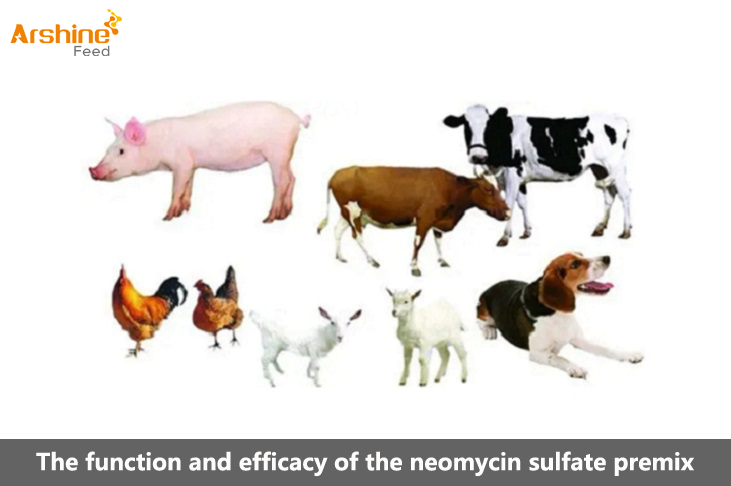

Neomycin Sulfate Premix is an aminoglycoside antibiotic. This product has good antibacterial effects on Enterobacteriaceae bacteria such as Staphylococcus (methicillin sensitive strains), Corynebacterium, Escherichia coli, Klebsiella, Proteus, etc. However, its activity is poor against various groups of Streptococcus, Streptococcus pneumoniae, Enterococcus, etc. Pseudomonas aeruginosa, anaerobic bacteria, etc. are resistant to this product. Bacteria have partial or complete cross resistance to streptomycin, neomycin, kanamycin, and gentamicin. Systemic use of neomycin has significant nephrotoxicity and ototoxicity, therefore it is currently limited to oral or local use.
The reason why neomycin sulfate is favored by veterinarians and breeders is mainly due to the advantages of the following two varieties.
1. The preferred intestinal medication for non antibiotic aquaculture.
For the treatment of poultry, the discontinuation period is only 5 days; After stopping the medication for 5 days, there was almost no drug residue in the muscles (which can be understood as no resistance).
2. The treatment of various intestinal diseases is efficient and economical.
This is mainly reflected in the "efficient" treatment under scientific and rational compatibility conditions, as well as the "economy" of drugs that are relatively cheap and have a small effective dosage.
So, how to use high-quality neomycin sulfate well and achieve "efficient" therapeutic effects?
This requires an understanding of the pharmacological and antibacterial spectrum of neomycin sulfate, as even the best drugs can be ineffective beyond its effective and pathogenic spectrum.
Neomycin sulfate is administered orally to livestock and poultry, and under normal circumstances, it is rarely absorbed (within 5%). However, if a large dose is taken orally continuously, especially when there are ulcers or inflammations in the intestinal mucosa, the gastrointestinal tract of livestock and poultry can still absorb a considerable amount of neomycin sulfate. Especially when the renal function of livestock and poultry decreases, the excretion of neomycin sulfate entering the body slows down, and the blood drug concentration in the body can significantly increase at this time.
For grassroots veterinarians and frontline drug users, it is important not to use systemic injection of neomycin sulfate, as it has significant nephrotoxicity. Therefore, currently, neomycin sulfate is only administered orally, and its effectiveness and safety have been used clinically in livestock and poultry for 60 to 70 years.
It is a commonly used medicine. However, many people have not demonstrated the effectiveness and effectiveness of this medicine.
The key issue is that when using neomycin sulfate veterinary drug products, it is necessary to combine the medication with at least two drugs when prescribing.
In the treatment of colitis type Escherichia coli, macrocyclic drugs such as neomycin combined with erythromycin thiocyanate, tylosin tartrate, or temicoxacin solution are used. Because when neomycin sulfate is used in combination with macrocyclic drugs, there is a synergistic effect between them, which can increase the efficacy; At this point, if TMP synergist is added again, the effect will be faster.
How to determine the specific clinical formula and the effective therapeutic dosage of neomycin sulfate, according to the ratio of 1g of neomycin sulfate to 8-10 pounds of water; The above-mentioned macrocyclic drugs are treated by mixing 1g of water with 10-15 pounds of water; The calculation method for the effective dosage of TMP is the sum of two drugs, and the increase in efficacy is calculated based on drug sensitivity testing at 3:1, 4:1, or 5:1!
Of course, the knowledge and usage techniques of neomycin sulfate mentioned above are only a small part.
The unique bactericidal mechanism and target of action of neomycin sulfate make it virtually non pharmacological incompatible with commonly used anti infective drugs in veterinary clinical practice. Only in terms of physical and chemical effects, neomycin sulfate reacts with cephalosporin antibiotics and needs to be used separately during administration.
After oral administration to chickens, neomycin sulfate is rarely absorbed by the gastrointestinal tract. Especially when the intestinal mucosa is intact, the total amount of neomycin sulfate absorbed into the bloodstream through oral administration is less than 5% of the total dosage.
However, once the digestive tract mucosa is ulcerated, or the epidermis peels off, or there is inflammation in the digestive tract mucosa, nearly 20% of the orally administered neomycin sulfate can enter the circulation of the body through the significantly increased permeability of the digestive tract mucosa and be transported to tissues and organs such as the liver, kidney, heart, lungs, and abdominal cavity.
The absorbed neomycin sulfate into the body is mostly concentrated in nucleated cells, especially in white blood cells with the highest content. Most of them are quickly excreted from the body through the kidneys. However, if renal function is impaired, the excretion of neomycin sulfate will be hindered and slowed down; And the vast majority of unabsorbed neomycin sulfate will be excreted from the body with feces. Within 24 hours, about 12% to 25% of the absorbed neomycin sulfate into the body is excreted by the kidneys, and about 50% to 90% is excreted by bile.
In terms of antibacterial spectrum, neomycin sulfate mainly has a strong effect on Gram negative bacteria, especially Escherichia coli and Salmonella; High doses of neomycin sulfate also have a good effect on Mycoplasma gallisepticum. However, increasing the dosage of drugs can significantly reduce their economic value and also increase the probability of adverse reactions. Therefore, in veterinary clinical treatment of Mycoplasma, in addition to using macrolide drugs; Abroad, more use of spectinomycin is being made.
However, the combination administration of neomycin sulfate with antibiotics such as penicillin, cephalosporins, floxacin, phosphomycin, tetracycline, and macrolide has higher, better, and more economical application value for more severe bacterial systemic infections and more difficult to treat respiratory diseases, especially when combined with some enhancers such as potassium clavulanate, methoxybenzydime, and sulbactam than using neomycin sulfate alone. This is the main reason why we advocate for the use of old drugs and new ones.
Add: Block 14, No.100, Luyun Road,Changsha 410205,China.
Mobile: +86 18874001228
Email: info@arshinefeed.com
WhatsApp: 8618874001228
WeChat: weiyuyan91